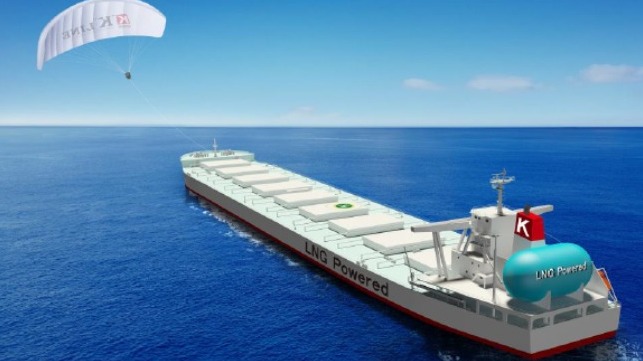K Line Expands Trial of Wind Kite to Post-Panamax Bulkers

Bulkers, which are large and rather slow vessels, continue to be a prime target for the shipping industry’s growing interest in wind-assisted propulsion. An increasing number of projects are planning to test rigid sails and rotors on bulkers, and today Japan’s “K” Line said it plans to expand its project with the French Airseas to include three post-Panamax bulkers in addition to its existing plans to begin testing the wind kite technology on two Capesize bulkers.
“K” Line has been working with Airseas, a spinoff from the French aerospace company AIRBUS, since 2017 to explore the system and confirm its potential impact on fuel savings and reduced emissions. The Seawind will be mounted on the bow of the vessel and is operated from the bridge when the conditions for wind power and wind direction and speed will provide effective wind force to assist propulsion power. The kite will unfold automatically and be stored on the bow when not in use.
Under the new agreement, “K” Line will purchase three additional Seawing systems from Airseas to be installed in post-Panamax bulkers. The company said it expects to achieve a similar reduction of greater than 20 percent in CO2 emissions with the post-Panamax vessels as is expected from the first installation on Capesize bulkers.
"K" Line recognizes that ships being built now will need to meet the decarbonization standards of the 2040s and 2050s, as regulators and customers step up pressure for the industry to decarbonize,” said Vincent Bernatets, Co-Founder and CEO of Airseas. “A true market leader wind propulsion system like the Seawing helps lay the long-term foundations for the sustainable shipping of the future by reducing emissions right now, in addition to delivering a strong return on investment in the short term via fuel savings."
At the end of 2021, Airseas announced that it would begin the first trials on an in-service vessel early in 2022 with a 5,200 dwt Ro-Ro, the Ville de Bordeaux, following collaboration and testing with Bureau Veritas. The vessel, which is chartered by Airbus and operated by Louis Dreyfus Armateurs transporting major aircraft components between France and the United States, was outfitted with a 500 m2 demonstration version of the sail.
“K” Line plans to deploy its first version of the Seawing system in December 2022. The specifications of the system have not been detailed, but Airseas has said the full-size version of the Seawing would be a 1000m2 parafoil, to fly at altitudes of nearly 1,000 feet capturing the stable higher altitude winds to assist vessel propulsion.
As the next step in their cooperation, “K” Line and Airseas will also work to integrate Seawing and “K” Line’s vessel data into a platform developed by the Japanese shipping company. The goal is to maximize the performance of the systems.
